|
These were all combined
to design a College that was specifically suited to Australian
requirements.
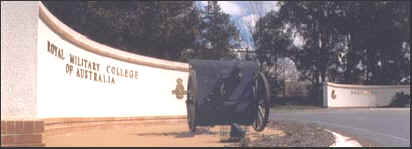
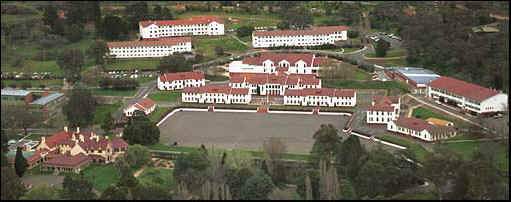
 Site Selection
Site Selection
RMC-D was situated on the
Campbell homestead in Duntroon Canberra. The family had named it after
Duntrune Castle, their ancestral home on Loch Crenan in Argyllshire,
Scotland. The Government first rented the Duntroon homestead for two years
and finally acquired the freehold to the estate and 370 acres of land
after the creation of the Federal Capital.
|
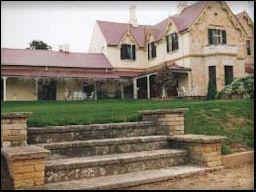
|
Duntroon was chosen after lengthy consideration. General Bridges had
stipulated that it should be nowhere near a big city like Sydney or
Melbourne as there would be a shortage of open ground for exercise
purposes.
As Canberra had been named as Australia's Federal Capital, it
was decided that a location few kilometres from the site of the proposed
city was the ideal location for the College.
|
Duntroon was chosen due to the nearby availability of unpopulated areas
which would be suitable for training. These areas are still used today and
are known as the Majura Range.
 Subsequent History
Subsequent History
Since its establishment,
graduates from RMC have served under the Australian Flag in every major
conflict. Throughout the colleges history the length of the course at RMC
has varied from 12 months to four years, however, the focus on producing
capable and credible officers for the Australian Army has remained
paramount.
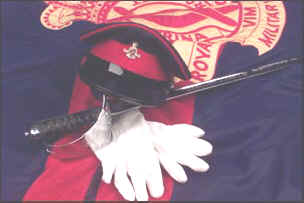
|
If you walk through the grounds of RMC-D you will feel a rich sense of
tradition and history.
Many of the buildings are heritage listed and the
gardens are kept in an immaculate state.
In conjunction with this the
College has formed many traditions over the past century, most of which
still exist today.
|
Perhaps the most notable reminder of RMC's tradition and heritage are the
seven wonders of RMC. These have been evolved over time by the cadets and
are learned by all cadets upon arrival at the College.
RMC-D
Traditions
Throughout the history of
the Royal Military College, a number of traditions have emerged. Like the
Seven Wonders of RMC, these have all been developed by the many classes of
cadets that have passed through the College. Some of these legends and
traditions are:
|
Casey.
Legend has it that years ago at RMC, Staff Cadet Casey, a member
of IV class, was skylarking prior to departure of the Corps on
Christmas leave and was inadvertently locked in a broom closet. He
was not missed from the leave draft and remained in the cupboard
until the Corps returned to RMC the following year
Casey's skeleton was found but his ghost still haunts the
corridors and cavities of RMC. As he will never graduate, to
appease his spirit, a place is set for him at every Graduation
Dinner and his skeleton is present at each Graduation Ball. The
horse he rides is called 'Invader'.
|
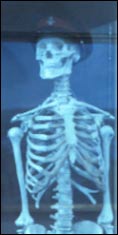 |
-
College War Memorials.
At the base of the flagpole, facing the parade ground, are five memorial
tablets listing the names of graduates of RMC, Officer Cadet School
Portsea and Officer Cadet Training Unit Scheyville, who have died on
active service. A wreath is laid beside these tablets by the Corps each
Anzac Day. As a mark of respect all cadets and staff salute the memorial
tablets on passing by them.
-
Days to Go Board. In
the Corps of Staff Cadets Mess there is a 'Days to Go' Board. A III Class
cadet changes it at 6:30 p.m. daily. By tradition, this is done by the
youngest member of III Class. This climaxes at the Graduation ceremony
when the cadet changes the board to nil days to go, accompanied by
appropriate drum rolls, trumpet fanfare and cheering of cadets.
-
Slouch Hat.
When the slouch hat is worn at RMC, it has become traditional that
the
chinstrap buckle is on the right side of the face and the brim is down.
General Bridges was wearing his slouch hat this way when he was fatally
wounded at Gallipoli. (Bridges was actually wearing
his hat back to front. Webmaster) The tradition was commenced at RMC in 1932. When the
slouch hat is worn ceremonially, (e.g. on ANZAC Days) it is worn in
accordance with the wider Army custom, i.e. brim up and chin strap on the
left hand side.
-
21st Birthday.
When a member of the Corps has a twenty-first birthday, their classmates
always help him or her to celebrate. By tradition the cadet concerned is
thrown up in the Cadet Mess, (in front of the Days to Go Board) to the
tune of 'Twenty-one Today'.
Barracks
Pictures
 |
 |
- The summer
graduation (Dec) of an RMC-D 1st class.
|
- Winter
graduation (shown above) takes place in winter Blues uniforms.
|
|